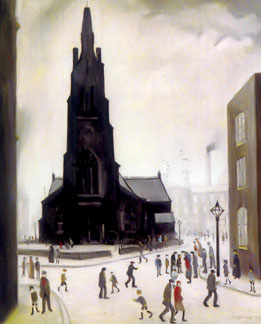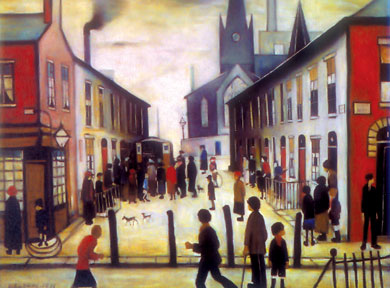Lowry exhibition at the Tate Gallery
by Gwen Herat
England, in all her parts, is always agog with pleasant expectations
when the summer fades with the onset of autumn, Autumn is ‘arts’ time in
London which is ablaze with exhibitions, theatre and symphonic musical
events at the famous venues. One could see the long queues.
 |
|
Street Scene with St. Simon's Church,
1928. oil paint on board, 43 x 38 cm. |
This year, I was very comfortable in not having to wear even a
cardigan though the chilly breeze kissed me at every turn. The Tate
Gallery was packed with visitors, tourists and art lovers who were
viewing Lowry and studying the paintings with intent. The paintings were
mostly from rural England of his time. None were flamboyant but very
characteristic in every detail, the colours were mostly sober with no
contrast, clashing with each other.The crowds explored the life and work
of the much-loved British painter. Lowry was a painter of modern life
which the French recalled in the age of Monet and the Impressionists.
Rent collector
The young Lowry was taught at the Manchester School of Art by the
gifted Frenchman, Adolphe Valette who preached the gospel of
Impressionism and pictured Manchester's mills and canals that later
influenced Lowry who became one of its disciples.
For 40 years Lowry painted the urbane landscape of Salford and
Manchester that are exhibited at today's Tate Gallery. The life on the
streets in Lowry's paintings are intense and resilient, always in search
of the new.
However, he had been an enemy of ‘Sentiment’ art that is visible in
today's exhibits. He has had access to the details of poverty and
respectability in the slums as a man who made his living as a rent
collector. His art never claimed false comradeship with the world it
took as its subject. He was an outsider. The streets were gloomy to him
but magnificent to his art and had been inspired by their beauty.
The exhibition reveals his long struggle to give that beauty form.
There were 27 oils painted up to October 1921. Of them, I liked most
were captioned ‘Suspension of Payment Manchester's Chemical Industry and
Textile Finishing that were from the Lowry Collection of Salford.
At the outset of his career, Lowry showed earlier and more
consistently in Paris than in London. From 1928 to 1933 his work was
accepted yearly at the spring and autumn salons. Parisian critics
understood at once the links of Lowry's art to their own modern
tradition. His paintings reminded them of Pissarion in its unassuming
openness to the details of everyday life of Utrillo in its simplicity
and of their earlier French Realists such as Gigh in their grim
compassion for the common man.
Heroism
Lowry had been an advocate that no painter turned his face to the
wind that blew from tomorrow and the heroism of modern life crowded in
all.
Subjects and colours for a new epic was everywhere and the painter,
the true painter, would be the one who would seize from life of the
present its epic dimension and make everyone see and understand in
colour or contour, how great and poetic we are in our attire.
Lowry had never been one that caught my imagination but this
exhibition has given me an insight into his theory of art. I found a
sense of philosophy in his art, the frustration of the poor and the
neglected that he unwittingly painted. They told me a long story about
his character, his vision for his countrymen and fate at large.
Street life
Lowry was a painter of the working class. He had one-track mind, was
fond of remarking that he only dealt with poverty, always gloomy but
this was not an adequate verdict on his art as a whole. Accidents
attracted him and what fascinated him most were the people they
attracted as his exhibits reveal. Beauty may be of many kind but it is
simple enough a fact.
 |
|
The Fever Man by Lowry
in oil on canvas. 43 x 53 cm, painted in 1935 |
The work of Lowry has quality but are uncompromising yet beautiful.
Many of us are comfortable in ourselves a little with public squares or
with light and colour on suburban roads, parks or gardens. But Lowry has
refused all comfortable delusions, the reason why I call him a little
bit philosophical. His Lancashire is grey with diminutive houses and if
there is an open space, it is of trodden earth as grey as the rest of
the landscape.
Ruined landscape
From the beginning of his artistic career, Lowry was determined to
paint landscape and the horizons in Salford, mostly narrow. But a few
miles away lay the moors and from the 1920s Lowry tried to find form for
the impact of the Industrial Revolution on nature.
His first vision on industrial revolution landscape were dismal to
the point of melodrama. He saw the rivers turned into polluted swamps
and dark ‘Satanic’ mills strectching as far as the eyes could see. This
wild vision of ecological disaster was a necessary first step to Lowry's
thinking of the mystery and the feeling of hopelessness never entirely
were off but in the end it was replaced by a more complex response.
The sense of waste and catastrophe gave way to a rueful, almost
admiring recognition of the ugly grandeur of the industrial scene. As a
modern painter, Lowry shows how the industrial revolution has
transformed the towns and their surroundings. His landscapes can be seen
as bleak, reflecting the painter's own mind. If it were not for his
loneliness, none of his works would have happened. Sadness attracted him
and there are some very sad things he found similar in himself. Lowry's
skies are mainly white because he wanted to find beautiful shades of
white in his work. He loved to see the skies become blurred and creamy
as it meets the land. His white backgrounds became a creamy grey-white.
That was the saga of Lowry's paintings.
(Next : The Patric Caulfield exhibition) |

